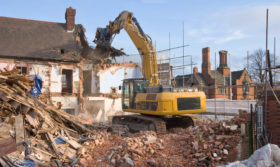
Next session this Thursday. Check out our course programme today!
Use code BUILD for 20% off
Next session this Thursday. Check out our course programme today!
Use code BUILD for 20% offAfter more than 30 years dealing with the planning system, it’s fair to say I’ve seen many changes. The days of popping into the council offices for a chat with the planning officer are long gone. Planning has gone digital in a big way, too.
Learn more: Complete Guide to Making a Succesful Planning Application
Meanwhile, other things remain the same, namely the endless government mantras about building more houses and simplifying the planning system, neither of which have got anywhere at all. So, in my many years of working in this field I’ve certainly had time to gather some thoughts about what parts of the system are the most infuriating and how they could be improved. In no particular order…
Planning is riddled with this, even down to job roles – a council’s head of planning is just that, but what is a director of place? The phrasing ‘local plans’ does what it says on the tin, but not after a regrettable excursion into ‘local development frameworks’, ‘core strategies’ and ‘development management documents’.
But we also now have neighbourhood plans – an extra tier, to keep things simple. Both local and neighbourhood plans go through a process of examination, following which the former are formally adopted, but the latter are ‘made’. It begs the questions, why the difference? At government level, guidance used to come from planning policy guidance documents (PPGs).
These were then consolidated into the national planning policy framework (NPPF). But no sooner was this brought out, than explanatory details were published in planning practice guidance again, but a different PPG. There is so much avoidable confusion.
To help you make your planning application, councils produce validation checklists. These documents list all the things you might have to submit with your application. However, they are geared towards large scale development and in many cases most of the reports, studies and details they seek are irrelevant to self builds.
Learn more: Beginner’s Guide to Planning Permission
This means you have to wade through the checklist putting a cross against all the irrelevant stuff. Failure to submit the checklist itself, even if it’s all crosses and no ticks, can result in your application not being validated.
Another tick box irritation is planning application forms. When applying for a new house, is it really necessary to have to say whether you’re storing hazardous substances, for instance, or whether yours is a waste management development? Forms could so easily be tailored to individual project types, which would avoid homeowners having to answer ‘no’ to innumerable irrelevant questions.
Applications and appeals are supposed to be dealt with in a timely fashion. But councils and the planning inspectorate, who deal with appeals, have devised cunning ways of circumventing tiresome targets.

t took three long years before Lesley Richardson was granted permission to build her dream home in Cornwall
For councils the first line of defence is validation. Delays there, coupled with asking for irrelevant or unnecessary details and nit-picking generally, slow down the starting of the clock on an application. Once begun, as the deadline approaches, councils ask for additional information and include a request for an extension of time. Unfortunately, this leaves you with little option but to agree.
The Planning Inspectorate are more blatant. Their cunning plan is just not to ‘start’ an appeal until it suits them – the ‘start letter’ might not appear for weeks or even months after you lodge the appeal. It’s cheating, plain and simple, but the root cause is underfunding resulting in short-staffing and so on. A little more money injected into the planning system could speed things up a lot.
Details on planning policy are incredibly hard to track down. At the local level, finding out which documents are relevant to daily decision-making can be difficult at best, especially if you’re not sure what you’re looking for. If you’re lucky enough to find an up-to-date local plan, then locating the policies you need can still be tricky.
They might be filed in a housing, urban or rural environment, or potentially a design section. Some local plans have indexes, some don’t. A greater degree of continuity in the appearance and structure of local plans would make life a whole lot easier.
At government level the worst offender is PPG. This one has an alphabetical index, which includes such gems as ‘Use of planning conditions’ and ‘When is permission required?’ If you want to look up something to do with conditions, you have to look under ‘u’; and if it’s permitted development you’re after, it’s under ‘w’.
So while the guidance itself might be technically sound, a little intuition and usability checking certainly wouldn’t go amiss.
Planning policy is rife with ambiguous phrasing. For instance, a replacement house should not be ‘significantly’ bigger than the original. Extensions should be ‘proportionate’. Planning permission will ‘normally’ be given… and so on. But what do these words mean? Occasionally they are defined in notes accompanying the policies. More often though, they mean whatever the planning officer applying them decides. Greater definition of these terms would bring much needed clarity.
If enough neighbours complain about your application, or if your local councillor doesn’t like it, the proposal might get called to planning committee, no matter if the planning officers support it.
Councillors who make up planning committees aren’t professional planners, indeed they have minimal training. Having sat through far too many committee meetings myself, I’ve witnessed all manner of bizarre arguments, misreadings of drawings and misunderstanding of policy.
This is hardly surprising when you ask a group of essentially lay-people to decide often complex policy and legal matters.
I don’t think there’s an easy answer for this one. But more training would help, as would a pro-active role for planning officers, who are often guilty of keeping quiet when they know the councillors’ discussion has taken a wrong turning.
A couple of years ago, my local council would let you take down a building that might otherwise be converted to a house and replace it with a new property. Meanwhile, the neighbouring council would only let you convert buildings of some age and character and then, preferably, to a business or holiday use, rather than a dwelling. Hugely different policy approaches applied within a few miles of each other.
Unsurprisingly, government policy guidance on conversions is no better. In green belt, the partial or complete redevelopment of some previously developed (brownfield) land, whether redundant or in continuing use, can be acceptable. In the same guidance, new homes in the countryside are only allowed where the development would re-use redundant or disused buildings and enhance its immediate setting. This means there’s a more generous policy in the more protected area, which makes no sense. Greater consistency would make life easier for planners and self builders alike.
Planning officers inevitably have their own thoughts about what they like and dislike, but they really shouldn’t let these override policy. Conservation officers are perhaps the worst culprits of this. Whether you could add a modern extension to an historic building, for example, is likely to depend much more on this professional’s personal tastes than anything written in policy. Greater oversight of conservation officers by planning officers might help, but then they themselves will probably have their own opinions.

David and Sharron Reetham were told they stood no chance of getting permission to build on their land, but after finding a local councillor to endorse their application, it passed at appeal
It seems like every new government is possessed of an irresistible urge to tinker with the planning system. And this means that it just keeps on changing – which is fine where those amendments are required in order to meet specific challenges, such as climate change or the advent of new technologies. But change for change’s sake just adds to the difficulties self builders face when navigating the system. Some sort of moratorium to avoid mere tinkering is long overdue.
Programmes on the television that feature planning applications generally show co-operative planning officers who come out to site, chat things over and work to resolve problems.
However, the reality is often that they don’t answer the phone (‘I’m sorry, we’re closed for Christmas’ was the voicemail message I got late in February from one officer) and they don’t respond to emails, either. Being short staffed is undoubtedly part of the problem, but some officers seem to manage to communicate while others don’t. Minimum standards of service, which officers are obliged to follow, could ensure at least a base level of communication, which would be so much better than nothing.

